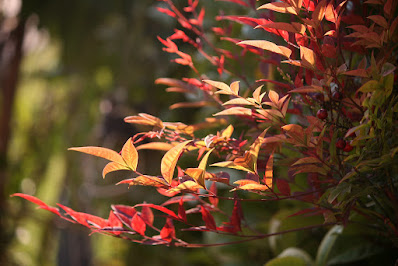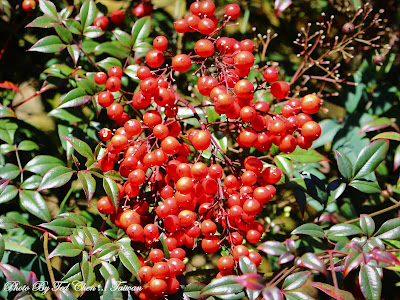Nandina domestica - Heavenly bamboo is adaptable to a variety of light conditions from full sun to partial shade and is adaptable to various soils...
Nandina domestica, also called as Heavenly bamboo, Sacred bamboo, is the only species of the genus Nandina. This species was described by Carl Peter Thunberg in 1781. The scientific is a Latinized version of a Japanese name for the plant, nan-ten. Despite its common name, is not a bamboo at all.
IDENTIFY NANDINA DOMESTICA - HEAVENLY BAMBOO
Nandina domestica is native to China, Japan, India. It was introduced to the United States and widely planted as an ornamental, now escaping and spreading from original plantings. It occurs under forest canopies and near forest edges.
It is an evergreen shrub which grows 3 to 9 feet tall and 3 to 5 feet wide. The plant has multiple bushy cane-like stems that resemble bamboo. The canes are 0.5-1 inch thick at maturity and have a distinct upright growth pattern. The young canes are red but turn brown as they mature and develop a yellowish coloration after they are cut. The leaves are tri-pinnately compound, dividing into many pointed leaflets 1-2 inches long that create a lacy pattern. New foliage is pinkish and bronze-red as it expands, turning to a rich green or bluish green upon full expansion. At higher elevations, red foliage develops in the fall.
Heavenly bamboo blooms in late spring to summer from the panicles axillary or terminal erect inflorescence with white or creamy white flowers. If the plants are grouped, shiny red spherical berries, 1/3 inch in diameter, follow the flowers in fall and winter. Single plants seldom fruit heavily. It spreads both vegetatively through underground sprouts from roots and by seeds.
It is a tough plant. Because of its clumping habit and moderate rate of growth, it is well suited to containers and small plantings in narrow or restricted areas. Its use can create a light, airy, vertical effect. It serves well as a screen and can be dramatic with night lighting. When properly maintained, nandina plantings will thrive for many decades.
NANDINA DOMESTICA - HEAVENLY BAMBOO CARE AND CULTURE
Cultural information should only be used as a guide, and should be to be adapted to suit you. Your physical location; where you grow your plants, how much time you have to devote to their care, and many other factors, will need to be taken into account. Only then can you decide on the cultural methods that best suit you and your plants.
Light:
Nandina domestica is adaptable to a variety of light conditions from full sun to partial shade. However, to achieve the most vibrant colors, the plant should be grown in full sun or some light afternoon shade. It can tolerate heavy shade, but will have brighter colors in full sun. If the shrub is grown in partial to full shade where the foliage remains wet, it may be prone to leaf spot diseases.
Temperature:
Heavenly bamboo can tolerate temperatures as low as -23 °C and high as 43 °C, but they will not survive long in such conditions. It grow best in a warm, slightly humid, wind-protected environment (USDA hardiness zones 6-10). In mild wine-growing areas, the ornamental shrub grows very well in the open land, as long as it can not get under intense winter sun in temperatures under severe frost.
In USDA 7 climate winters, it will freeze to the ground, but will recover quickly in spring if roots are undamaged by frozen soil. For gardeners from regions with cold winters, it is best grown in containers so it can be overwintered indoors.
Substrate and growing media:
Nandina domestica is adaptable to various soils but grows best in rich, well drained, loamy soil with ample water. It may become chlorotic (yellow) in strongly alkaline soils. It tolerates wind, wet conditions, drought, and soil compaction and is moderately tolerant of soil salinity.
The plant can be planted any time of year except midsummer, although spring and autumn provide the best conditions to establish new roots. Space the shrubs according to their mature size. Plant them in holes that are twice as wide but the same depth as their original nursery pot. Water well after planting. Spread a 2-3 inch thick layer of mulch over the root zone after planting, which will help keep weeds at bay while also keeping the soil moist. Install an 18-inch deep root barrier around the growing site to keep the shrub's roots from spreading.
It is also grow well in containers if you live in a region with cold winters as they cannot survive freezing temperatures for very long and the plant can easily be overwintered indoors. When grown in a container, the plant should repot every 2-3 years. It need to be watered more frequently when grown in a container versus a garden.
Watering:
During its first growing season, water deeply and regularly to establish an extensive root system. Ensure the soil is kept consistently moist but never waterlogged. The plant grown in containers will need to be watered even more frequently than plants grown in the garden. Once well-established, mature plants are more resistant to drought and can tolerate short periods of drought more readily.
After the first growing season, water as needed. It need regular watering in hot, dry areas or if they are grown in porous soil. Provide 1 inch of water each week if the soil feels dry beneath the surface.
Fertilizer:
To maintain the plants, use a light fertilizer application of a slow-release complete formulation (containing N, P, and K) three or four times a year. Iron sulfate or iron chelates can be used to correct leaf chlorosis in alkaline soils.
Pruning and mulching:
The canes do not branch, and therefore pruning must be done carefully. An annual spring pruning of one or more trunks at the ground level encourages new shoots and foliage at the lower levels. It is desirable to keep lacy foliage growing all along the trunks from bottom to top. Unfortunately, many gardeners disfigure the natural graceful shape of an individual nandina shrub by pruning them incorrectly. Commonly, bushes are sheared into square or oblong shapes and all the lower foliage is pruned off the bottom of the trunks. The poor shrub loses its identity and now resembles a near naked plant only sparsely clad in greenery and standing on stork legs.
Mulching with at least 3 inches of organic matter helps to reduce the growth of weeds, conserves soil moisture, and provides micronutrients
Pests and diseases:
Heavenly bamboo has no serious insect or disease pests, but it is occasionally bothered by scale and mites, and is an amazingly trouble-free plant. But you should know that all parts of the plant are poisonous, containing compounds that decompose to produce hydrogen cyanide, and could be fatal if ingested. The berries are considered toxic to cats and grazing animals. Excessive consumption of the berries will kill birds such as cedar waxwings, because they are subject to cyanide toxicosis, resulting in death to multiple individuals at one time.
Propagation:
Nandina domestica is usually propagated by seeds. Collect mature seeds in the fall and hold them in dry storage at 40°F to develop the rudimentary embryo. Plant the seeds in the summer; they will take about 60 days to germinate. The seedlings grow slowly, and several years are needed to produce a saleable plant.
Suckers arising from the base of old plants may be removed and planted. Vegetative propagation from cuttings is less effective but has been successful when rooting compounds are used after the wound has hardened. One rooting compound formulation reported to be successful is 2500 ppm IBA + 1500 ppm NAA.
Tissue culture techniques also have been successful for propagating nandina.
BUY NANDINA DOMESTICA - HEAVENLY BAMBOO AND RELATED PRODUCTS
BUY ANOTHERS SPECIES AND VARIETIES OF NANDINA GENUS HERE!
















COMMENTS